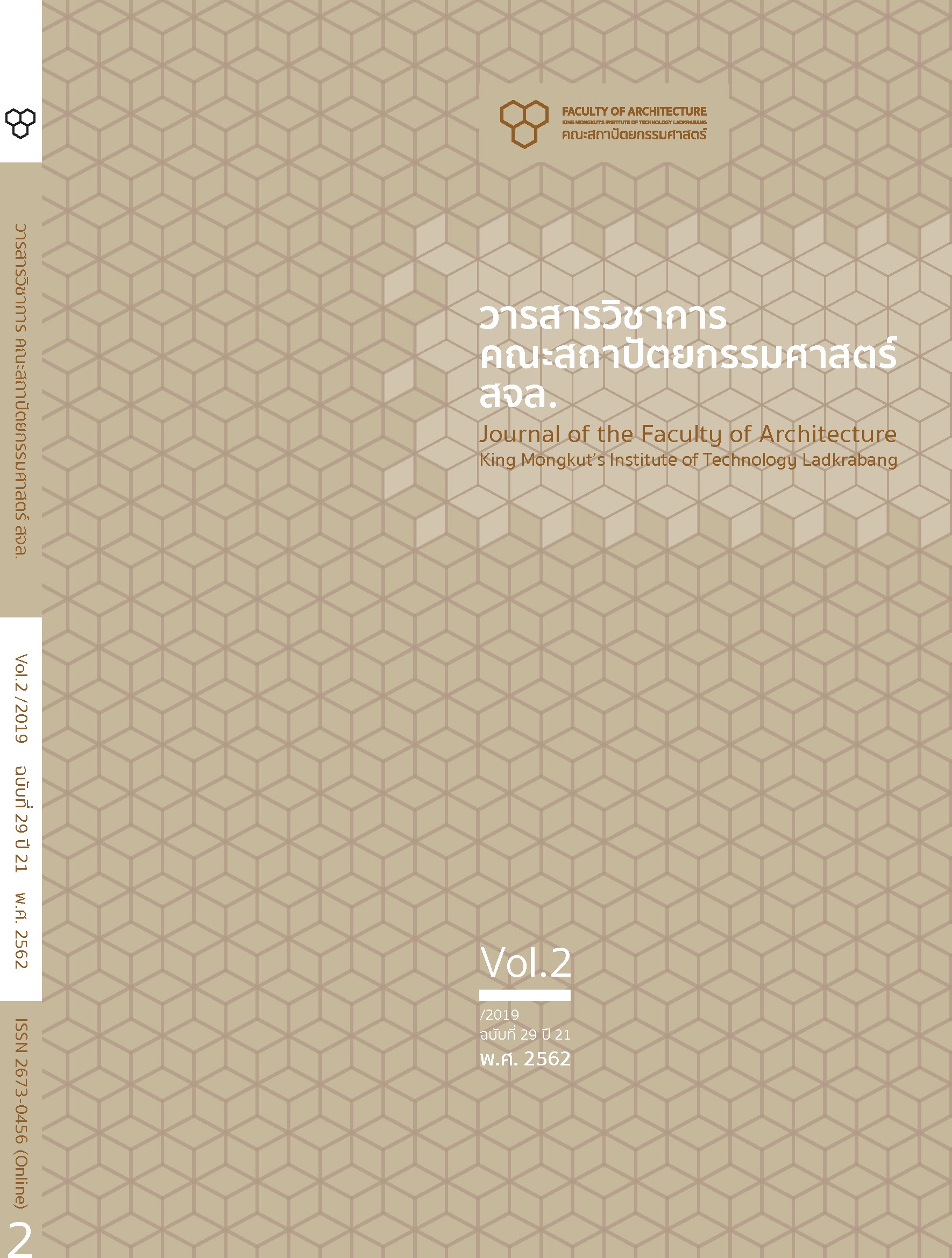Factors in Temporary Settlement of Sea Nomads in Phang-Nga Province and Krabi Province
Main Article Content
Abstract
บทคัดย่อ
บทความนี้มุ่งค้นหาปัจจัยในการตั้งถิ่นฐานชั่วคราวของชาวเล เป็นงานวิจัยภาคสนาม กลุ่มตัวอย่างในการวิจัยใช้วิธีสุ่มตัวอย่างแบบเจาะจง โดยการกำหนดคุณลักษณะขึ้นเพื่อเป็นบรรทัดฐานในการคัดเลือก คือ ชาวมอแกนอ่าวบอนใหญ่ หมู่เกาะสุรินทร์ จังหวัดพังงา และชาวอูรักลาโว้ยบ้านโต๊ะบาหลิว เกาะลันตาใหญ่ จังหวัดกระบี่ กรอบแนวคิดทางมานุษยวิทยาที่นำมาใช้ คือนิเวศวิทยาวัฒนธรรม จึงเป็นการพิจารณาสถาปัตยกรรมในฐานะเป็นวัฒนธรรมทางวัตถุอย่างหนึ่งที่เกิดจากการสร้างสรรค์ของมนุษย์ ผลการวิจัยค้นพบว่า ในอดีตชาวเลใช้ชีวิตส่วนใหญ่อยู่ในทะเลที่อุดมไปด้วย ทรัพยากรธรรมชาติ ที่มีความสมบูรณ์และมีความหลากหลาย แต่ในทางกลับกันพื้นที่แห่งนี้มีโอกาสเกิดภัยธรรมชาติ ถือว่าเป็น “พื้นที่วิกฤต” ซึ่งไม่เหมาะสมต่อการตั้งถิ่นฐาน ชาวเลมีการปรับตัวให้เข้ากับธรรมชาติมากกว่าการเข้าไปจัดการทำให้แบบแผนการดำรงชีพขึ้นอยู่กับฤดูกาล โดยเฉพาะอิทธิพลของลมมรุสม ถือว่าเป็นเงื่อนไขในการตั้งถิ่นฐาน ปัจจัยในการตั้งถิ่นฐาน สามารถจำแนกออกเป็น 2 กลุ่มใหญ่ ได้แก่ ปัจจัยด้านสิ่งแวดล้อมทางธรรมชาติ และปัจจัยด้านสิ่งแวดล้อมทางวัฒนธรรม ปัจจัยด้านสิ่งแวดล้อมทางธรรมชาติ ได้แก่ ภูมิ ประเทศ (ทะเล แหล่งกำบังภัยธรรมชาติ ชายฝั่งและพื้นที่ป่า) ภูมิอากาศ และแหล่งทรัพยากรธรรมชาติ มีอิทธิพลอย่างมากในช่วงวิถีชีวิตเร่ร่อนทางทะเลที่สัมพันธ์กับการตั้งถิ่นฐานชั่วคราว นำมาสู่การปรับที่อยู่อาศัยเพื่อรองรับวิถีชีวิตที่มีการอพยพโยกย้ายบ่อยครั้งในฤดูมรสุมตะวันออกเฉียงเหนือ และการปรับที่อยู่อาศัยเพื่อรองรับการอาศัยอยู่ติดที่ในฤดูมรสุมตะวันตกเฉียงใต้ ปัจจัยด้านสิ่งแวดล้อมทางวัฒนธรรม โดยเฉพาะปัจจัยภายนอก ได้แก่ กิจกรรมทางเศรษฐกิจ นโยบายของรัฐความช่วยเหลือจากหน่วยงานต่างๆ และการรับวัฒนธรรมของคนกลุ่มอื่นมีอิทธิพลในช่วงของการเปลี่ยนแปลงที่สัมพันธ์กับการตั้งถิ่นฐานถาวร
คำสำคัญ: ชาวมอแกน ชาวอูรักลาโว้ย ปัจจัยในการตั้งถิ่นฐาน สถาปัตยกรรมพื้นถิ่นนิเวศวิทยาวัฒนธรรม
Abstract
This article aims to search for the factors of Sea Nomads' temporary settlement. The research is based on a field study, using the purposive sample specifically selected namely; Moken ethnic group in Bon Yai bay, Mu Ko Surin in Phang Nga province, and Urak Lawoi ethnic group in Baan To - Baliew, Lanta Yai Island, Krabi province. The cultural ecology, in the anthropological framework, was adopted as the considerable criteria. The result showed that in the past most of the Sea Nomads lived close to the sea areas plentiful with diverse natural resources. However, the areas, considered as critical areas, were still at risk having natural catastrophe, and was not suitable for habitation. Instead of changing their surrounding contexts, the Sea Nomads adapted themselves to contexts, in relation to annual seasons and the dynamic of natural surroundings, with temporary settlement. In terms of relevant factors and conditions, it was found that the influence of seasons, especially monsoons, became the essential factor for Sea Nomad’s settlement. The factors can be divided into two main groups, namely 1) natural environment and 2) cultural environment. The first group includes 1) geographical aspects; such as sea, whether shelter, shore, and forests, 2) weather conditions, and 3) natural resources, which have significant influences on the Sea Nomads’ ways of living. The diversity of geographical aspects was considered as main factor for the Sea Nomad’s vagrancy and setting temporary settlement. The second group is focused on such external factors as economic factors, government policies, NGOs’ aid, and other cultural acceptance from others. These also have significant influences on the Sea Nomad’s permanent settlements.
Keywords: Moken Ethnic Group, Urak Lawoi Ethnic Group, Settlement Factors, Vernacular Architecture, Cultural Ecology
Article Details
This work is licensed under a Creative Commons Attribution-NonCommercial-ShareAlike 4.0 International License.
Copyright Transfer Statement
The copyright of this article is transferred to Journal of The Faculty of Architecture King Mongkut's Institute of Technology Ladkrabang with effect if and when the article is accepted for publication. The copyright transfer covers the exclusive right to reproduce and distribute the article, including reprints, translations, photographic reproductions, electronic form (offline, online) or any other reproductions of similar nature.
The author warrants that this contribution is original and that he/she has full power to make this grant. The author signs for and accepts responsibility for releasing this material on behalf of any and all co-authors.
References
ฉัตรชัย พงศ์ประยูร. (2536). การตั้งถิ่นฐานมนุษย์ทฤษฎีและแนวปฎิบัติ. กรุงเทพฯ: โรงพิมพ์จุฬาลงกรณ์มหาวิทยาลัย.
ชนัญ วงษ์วิภาค. (2530). นิเวศน์วิทยาวัฒนธรรม. กรุงเทพฯ: โรงพิมพ์มหาวิทยาลัยศิลปากร.
ธนภรณ์ วัฒนสุข. (2557). อูรักลาโว้ยการเปลี่ยนแปลงของสังคมสู่พัฒนาการของเรือนพื้นถิ่น: กรณีศึกษาชุมชนแหลมตุ๊กแก หมู่ 4 ตำบลรัษฎา อำเภอเมือง จังหวัดภูเก็ต. (วิทยานิพนธ์ปริญญาศิลปศาสตรมหาบัณฑิต สาขาวิชาสถาปัตยกรรมพื้นถิ่นบัณฑิตวิทยาลัย, มหาวิทยาลัยศิลปากร).
นฤมล อรุโณทัย, พลาเดช ณ ป้อมเพชร, อุษา โคตรศรีเพชร, กิ่งแก้ว บัวเพชร และจีระวรรณ บรรเทาทุกข์. (2557). ทักษะ วัฒนธรรมชาวเล ร้อยเรื่องประมาณชาวเล มอแกน มอแกลน และอูรักลาโว้ย ผู้กล้าแห่งอันดามัน. กรุงเทพฯ: ศูนย์มานุษยวิทยาสิรินธร (องค์การมหาชน).
นฤมล อรุโณทัย. (2549). รายงานวิจัยโครงการประชาสังคมและชุมชนเข้มแข็งในบริบทของกลุ่มชายขอบ: กรณีศึกษากลุ่มชาวเลในประเทศไทย. กรุงเทพฯ: สำนักงานกองทุนสนับสนุนงานวิจัย (สกว.).
นำพวัลย์ กิจรักษ์กุล. (2528). ภูมิศาสตร์การตั้งถิ่นฐาน. กรุงเทพฯ: โอเดียนสโตร์.
วีระ อินพันทัง. (2559). สิ่งแวดล้อมสรรค์สร้างพื้นถิ่น : การดำรงและการเปลี่ยนแปลง. หน้าจั่ว. 30 (มกราคม-ธันวาคม 2559), A - 127 – A - 142.
สมเกียรติ สัจจารักษ์. (2554). แนวทางการส่งเสริมการเรียนรู้เพื่อรักษาอัตลักษณ์ชาวเลมอแกน. (วิทยานิพนธ์ ปรัชญาดุษฎีบัณฑิต สาขาวิชาการศึกษาตลอดชีวิตและการพัฒนามนุษย์ บัณฑิตวิทยาลัย, มหาวิทยาลัย ศิลปากร).
Attavanich, M. (2016). A Study of Living Conditions in Post - Tsunami Houses: The Case of the Moklen Ethnic Minority in Phang Nga Province, Southern Thailand. (Doctoral thesis, Laboratory of Global Environmental Architecture Graduate School of Global Environmental Studies Kyoto University, Japan).
Carr, M. (1997). New Patterns: Process and Change in Human Geography. Tennessee: Thomas Nelson and Sons.
Clarke, I. J. (1965). Population Geography. Oxford: Pergamon Press.
Doxiadis, A. C. (1968). Ekistics: An Introduction to the Science of Human Settlements. Oxford: Oxford University Press.
Ivanoff, J. (1999). The Moken Boat: Symbolic Technology. Bangkok: White Lotus.
Robinson, H. A., Morrison, L. J., Muehrcke, C. P., Kimerling, J. A. and Guptild, C. S. (1995). Elements of Cartography. New York: Wiley.
Spencer, J. E. and Thomas, W. L. (1969). Introducing Cultural Geography. New York: Wiley.
Trewartha, T. G. (1969). A Geography of Population: World Patterns. New Jersey: John Wiley and Sons.


